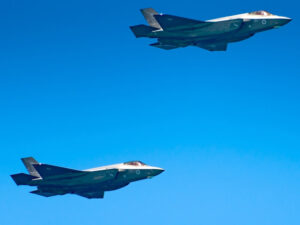The U.S. Navy has been the focus of recent criticism for its shipbuilding woes, to include delays to the Columbia-class ballistic missile submarine of up to 16 months in the first vessel’s delivery. The submarine industrial base has come under regular attack as well for its inability to build enough ballistic missile and attack submersibles to fill both U.S. and now Australian submarine needs through the AUKUS agreement.
While it is important to address these naval shortcomings, it is inexcusable to ignore serious problems in other legs of the nuclear triad that has provided U.S. strategic deterrence since 1960.
If the triad is to remain viable into the 21st century, then all three of its elements ought to endure the same level of programmatic scrutiny. The Air Force’s troubled Sentinel Intercontinental Ballistic Missile (ICBM) is one such program that demands greater scrutiny.
Cost overruns and schedule delays for Sentinel
While it was originally suggested that the Air Force upgrade existing silo-based Minuteman III missiles, in 2021 the service made the case that the cost to do so would be $38 billion more than a program to develop and field what became the Sentinel missile. Based in large part on that projection, the service proceeded with the Sentinel.
But in the ensuring years, the program has withstood overruns and delays. The Sentinel was in Nunn-McCurdy breach in January, growing 37% in cost from a projected 2020 cost of $118 million per missile to $162 million in 2024.
The projected total cost of the Sentinel – now at $130 billion for upwards of 450 missiles in refurbished, 50-plus year old Minuteman III silos — is now almost even with the expected $130 billion price tag for the much more survivable 12-vessel, Columbia class ballistic missile submarines (SSBNs)
In addition to its Nunn-McCurdy breach, the next-generation ICBM is delayed due to supply chain and developmental delays in the weapon’s guidance system, with its first flight not scheduled to occur before February 2026, a slip of two years.
Survivability questions for fixed-silo missiles
The survivability of large, fixed-silo ICBMs has been a point of contention since the mid 1970’s. The Peacekeeper ICBM, part of the Reagan administration’s modernization of U.S. nuclear forces in the 1980’s, was originally proposed as a rail-mobile system with the missile and its launch apparatus contained within a disguised refrigerator rail car. At the first sight of Soviet nuclear “threat,” these nuclear missile-laden railcars were to be “flushed” into the U.S. rail system, making their identification and targeting nearly impossible.
The Cold War ended before this system could be adequately tested, and the Peacekeeper was deployed as a conventional, silo-mounted missile with 50 missiles produced. The last Peacekeeper retired in 2005. The U.S. ground deterrent continues to rely on the 1970’s-era Minuteman III weapon.
The military developed a smaller, single-warhead, road-mobile ICBM called the “Midgetman” in the 1980’s as a more survivable strategic weapon. It was deployed by an eight-wheel drive, hard mobile launcher vehicle with radiation hardening that appeared like something from a doomsday movie on nuclear war. The Midgetman was canceled at the end of the Cold War as the nuclear threat diminished with the demise of the Soviet Union.
The vulnerability of fixed, land-based missiles is likely much greater today than in 1991 given the proliferation of surveillance tools and access to satellite data. In a recent op-ed, Rep. Adam Smith of Washington, ranking Democrat on the House Armed Services Committee, suggested that the U.S. could “pursue the feasibility of fielding some portion of the future ICBM force in a road mobile configuration,” a move that might reduce some of the ballooning basing costs and silo-rebuilds that have added much to the bill for Sentinel.
Changes that could help Air Force ICBM procurement
While Air Force and Navy ballistic missiles are reliable, the Air Force Sentinel program might benefit from the Navy’s organizational method for managing its ballistic missiles, especially as the Air Force introduces a new ICBM.
The Navy answer to the reliability part of the SSBN program since 1955 has been located in the Strategic Systems Program (SSP) office. Formed by Chief of Naval Operations Adm. Arleigh Burke to aid in the development of the Polaris missile SSBN program, SSP develops strategic weapon systems, is charged with sustaining them over their lifecycle and safeguarding the shared U.S./United Kingdom SSBN program shared capabilities. SSP controls U.S. strategic systems centrally from “cradle to grave” to ensure system reliability over time.
The Air Force also tests its weapons rigorously, but the authority for Air Force strategic systems is spread across multiple operational and administrative commands. The Minuteman missile testing program, for example, is owned by its operational commander, U.S. Air Force Global Strike Command, and not managed by an independent evaluation authority, but rather a subordinate Global Strike Command authority, the 377th test Evaluation Group, commissioned in 2021.
The Air Force Test and Evaluation Command only stood up an ICBM test facility at Vandenberg Air Force Base in 2023. An independent testing command might be more likely to recommend deployment improvements based on testing, and long-term data accumulation.
Mobile variants to improve survivability
Armed with such an independent test arm, the Air Force might redevelop the Sentinel with an alternative deployment scheme that does not rely of the same, long-targeted, 1970’s-era missile silos. Rail and road-mobile systems might inject a highly level of survivability and more uncertainty into the ability of an opponent to locate and target U.S. land-based ballistic missiles.
A big part of the unexpected cost overruns of Sentinel comes from the massive reworking of aging Minuteman silos. A move to a truck or rail-mounted system, perhaps based on shipping containers, might reduce costs. Given that treaty obligations removed multiple independently targetable reentry vehicle (MIRV) warheads, a smaller, mobile, land-based weapon may now be the most practical choice in land-based deterrent system.
The Air Force must look past 1970’s conventions in land-based ballistic missile deployment, especially when they account for cost-overruns, and embrace a mobile, 21st century ICBM force.







